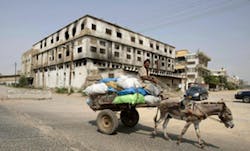Are Wal-Mart’s Clothes Washed in Blood? New Report Analyzes Two Garment Factory Fires in Bangladesh and Pakistan
“Fatal Fashion,” a new report by the Clean Clothes Campaign (CCC) and the Centre for Research on Multinational Corporations (SOMO), analyzes two recent garment factory fires in Pakistan and Bangladesh that claimed the lives of more than 400 workers. In September 2012, a fire raged at Ali Enterprises in Karachi and in November 2012, a factory fire broke out at Tazreen Fashions Limited in Dhaka. The two companies produce clothing for well-known European and American clothing brands and retailers, including KIK, C&A and Wal-Mart.
In addition to the hundreds of workers who died, many others were severely injured. Sub-standard buildings, poor emergency procedures, blocked fire exits, overcrowded workplaces and vastly inadequate control and auditing practices resulted in an extremely high death and injury toll.
Mohammad Saleem, 32, who broke a leg after jumping out of the second floor of the Ali Enterprises building, said he and his colleagues were hard at work on the day of he fire when “suddenly, the entire floor filled with fire and smoke and the heat was so intense that we rushed towards the windows, broke its steel grille and glass and jumped out,” Saleem said.
Another survivor, Allah Warayo, said there was a stampede as the fire spread. He ended up jumping from the third floor, but five members of his family did not escape. “We started running towards the exit. There were 150-200 people all running and pushing each other. I fell down unconscious. Then I managed to get some air from a vent. I started screaming. A crane made a hole in the wall and I was able to jump. I begged the rescue workers to help my relatives, but noone paid any attention.”
Locked Exits, Poor Response
In an interview with CCC, a survivor of the Ali Enterprises factory fire reported that all of the windows at Ali Enterprises were barred, preventing workers from escaping the building. The only exits available to workers were staircases located next to lift shafts through which the fire spread to the upper floors of the factory. With the dark and the smoke workers were unable to find their way to these exits. Other potential exits, which included doors between departments, were locked.
“The report demonstrates that companies and governments knew about the risks, but failed to take sufficient measures to prevent the fires from happening or to address the needs of the victims afterwards,” says Martje Theuws from SOMO. “Governments and companies should act in accordance with the internationally recognized state duty to protect human rights and the corporate responsibility to respect human rights, as laid down in the United Nations Guiding Principles on Business and Human Rights.”
“Fatal Fashion” notes that both factories had been subjected to numerous factory audits. Ali Enterprises received the SA8000 certificate just three weeks before the fire. Structural and highly visible safety deficits and falsified documentation of fire drills remained unnoticed by auditors. When safety hazards were noticed, companies failed to take adequate action to mitigate them. A Business Social Compliance Initiative (BSCI) audit found evidence of safety violations at Tazreen Fashions, however, the report was put in confidential database, and no follow-up was conducted.
After the Tazreen Fashions fire, Wal-Mart labels were found in the burned-down factory. Two days after the fire, on Nov. 26, 2012, Wal-Mart said in a statement that the factory no longer was authorized to produce merchandise for Wal-Mart. The company declined to say when exactly it had stopped working with Tazreen and for what reasons. According to Walmart, another supplier, which was later identified as Success Apparel, had subcontracted work to Tazreen “without authorization and in direct violation of our policies.”
However, “Fatal Fashion” notes that documents from mid-September, found in the factory after the fire, indicate that five of the 14 production lines were making apparel for Walmart. There is documented evidence that subcontracting contracts for Wal-Mart orders came to Tazreen Fashions through different Wal-Mart suppliers.
The factory fires discussed in the new report are symptomatic of an ailing system, claim CCC and SOMO. They reflect “systemic flaws on the level of government protection of human rights, a deathly reliance of international brands on a failed auditing model where even the absence of a fire exit remains unaddressed and a gross disrespect shown by the garment industry for workers’ rights,” according to the report.
Fires Continue, Tragedies Mount
Since the Tazreen fire in Dhaka, another 28 factory fires have been reported in Bangladesh alone, injuring at least 591 more workers and killing another eight. In the report, SOMO and CCC call upon companies to fundamentally alter their reliance on audit firms and certification bodies to undertake their inspections.
“These firms lack safety expertise, are not trusted by workers and trade unions rendering their worker interviews implausible and are commonly paid by the factory owner. Even when they detect violations, they fail to resolve them,” said Tessel Pauli of CCC. “Instead, buyers should implement a safety program that includes independent inspections with mandatory reparations, public disclosure of workplace locations and inspection reports and a central role for workers and unions. In addition companies should ensure pricing covers the costs of eliminating deathly hazards and operating safely.”
SOMO and CCC have formulated detailed steps for responsible employers to take to improve compensation for victims and workers, the implement fire safety programs and the adopt effective auditing practices.
A Dutch governmental mission to Bangladesh aims to improve sustainable garment production – in particular regarding fire safety and living wages – a move welcomed by CCC and SOMO. “We look forward to the Dutch government playing a leading role in this effort,” said Pauli.
About the Author

Sandy Smith
Sandy Smith is the former content director of EHS Today, and is currently the EHSQ content & community lead at Intelex Technologies Inc. She has written about occupational safety and health and environmental issues since 1990.

